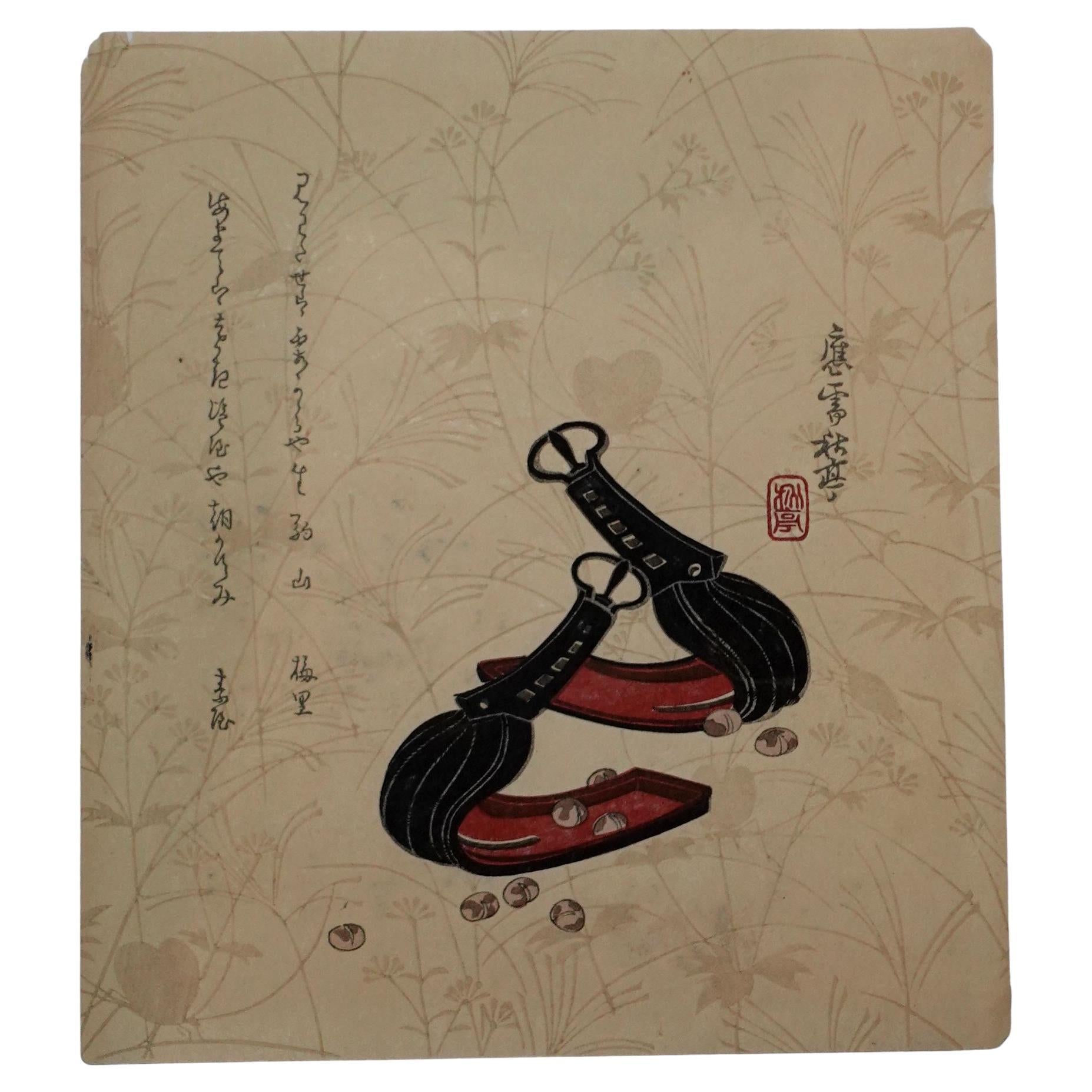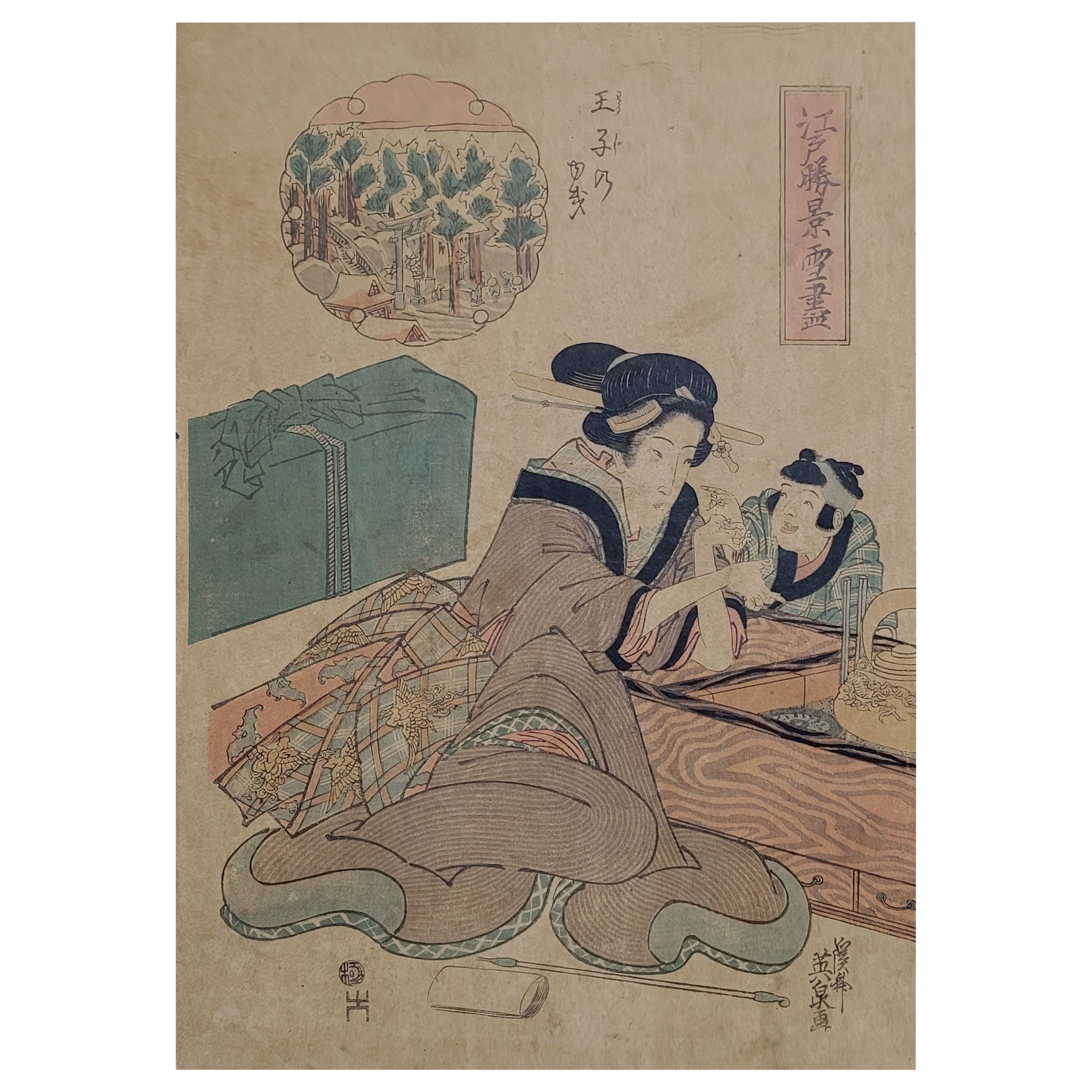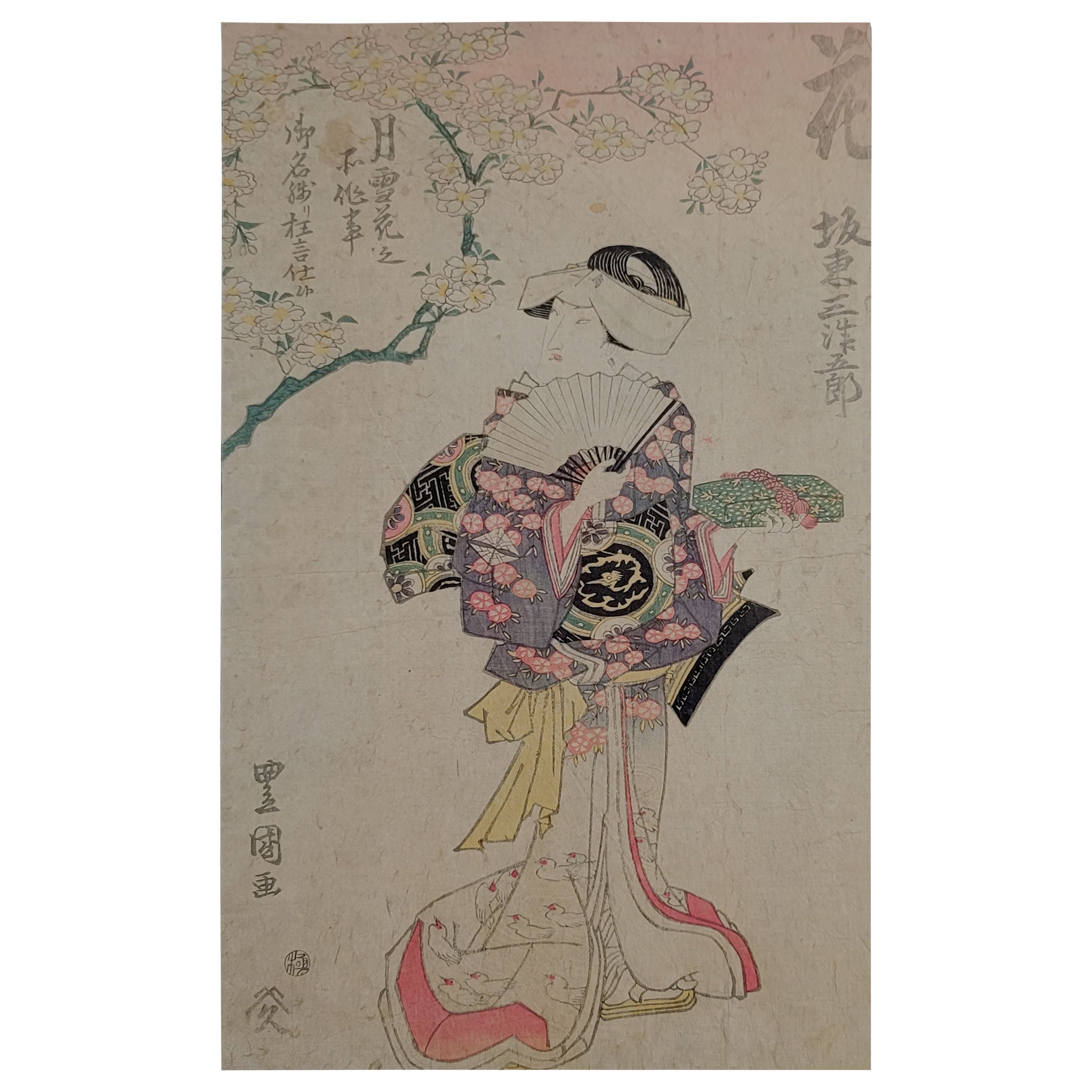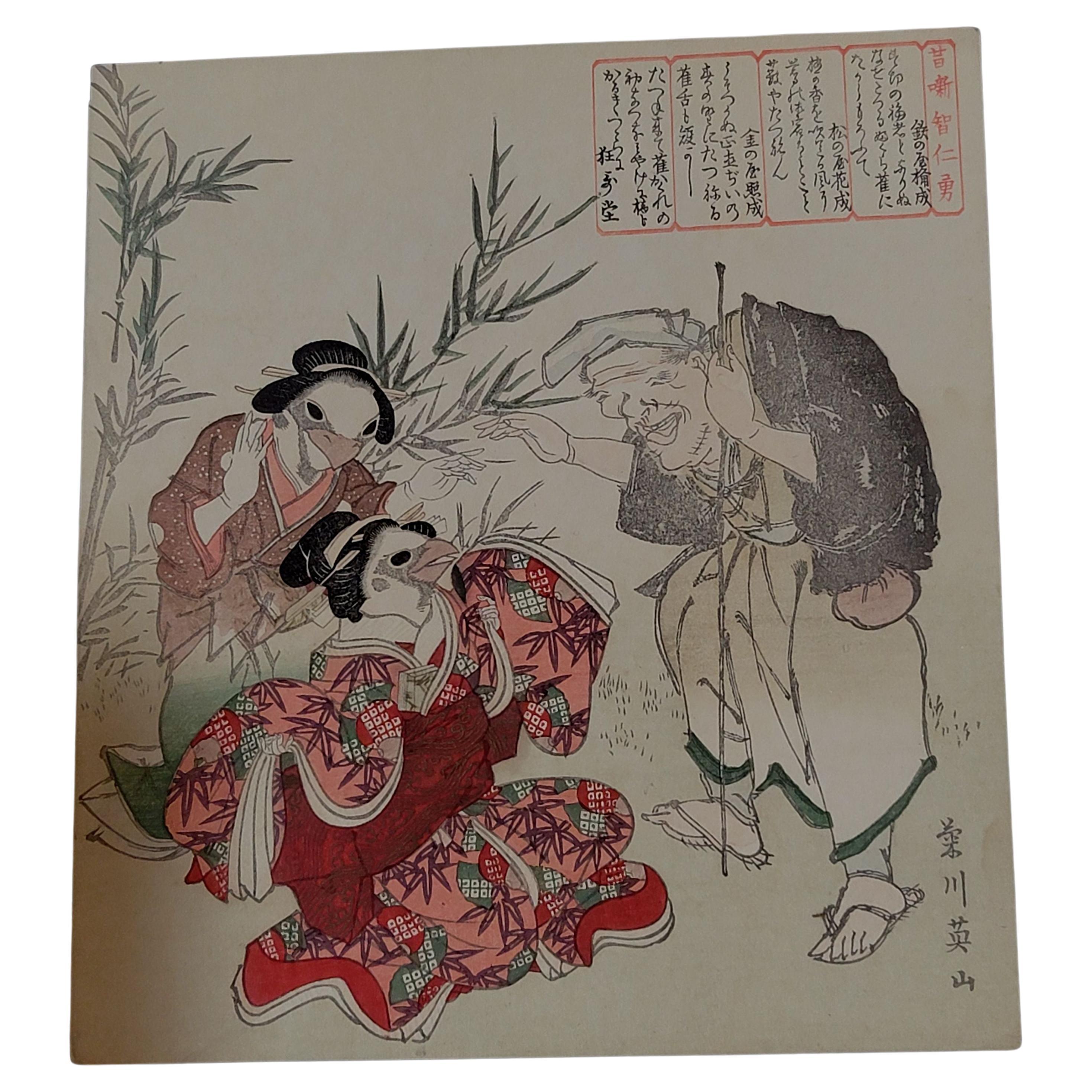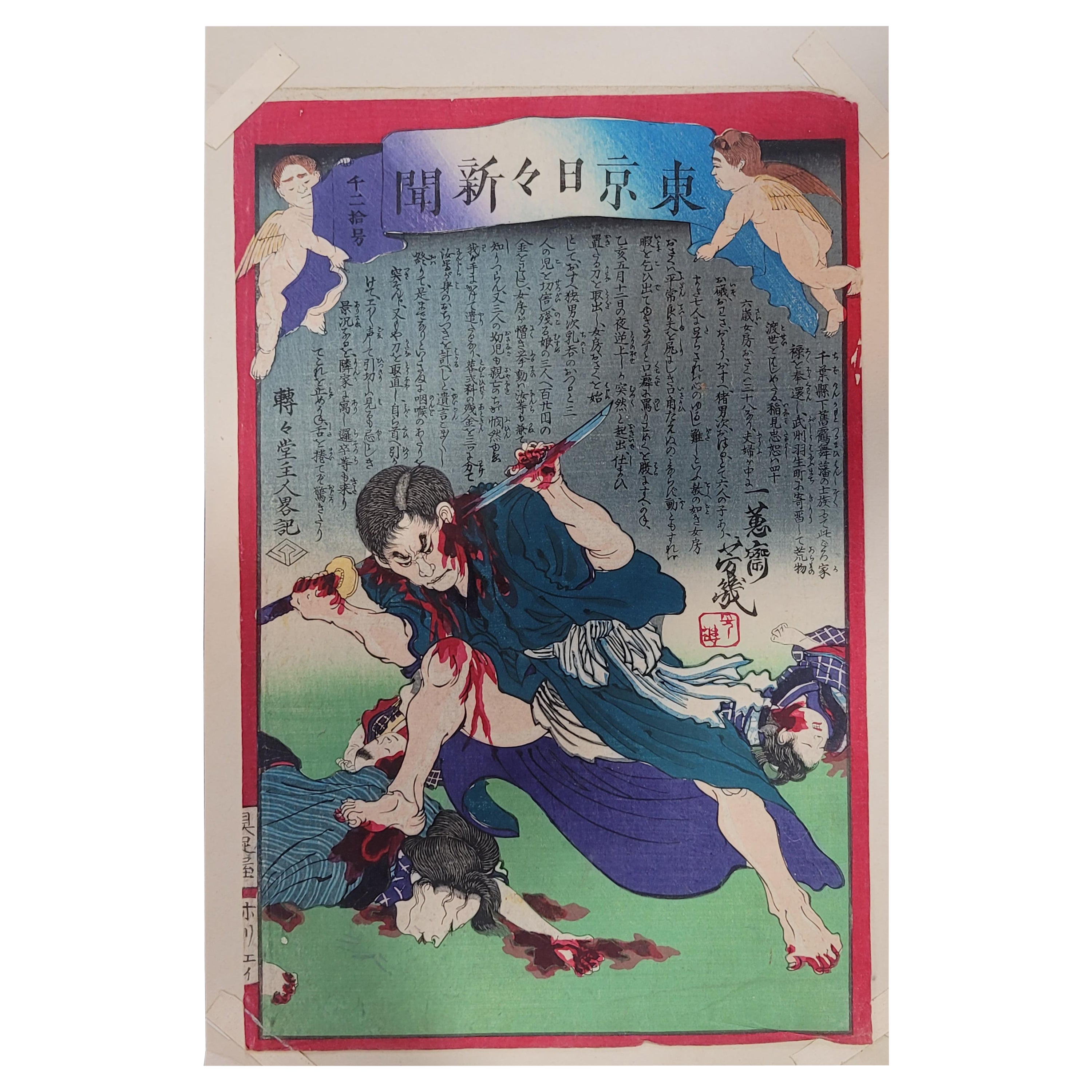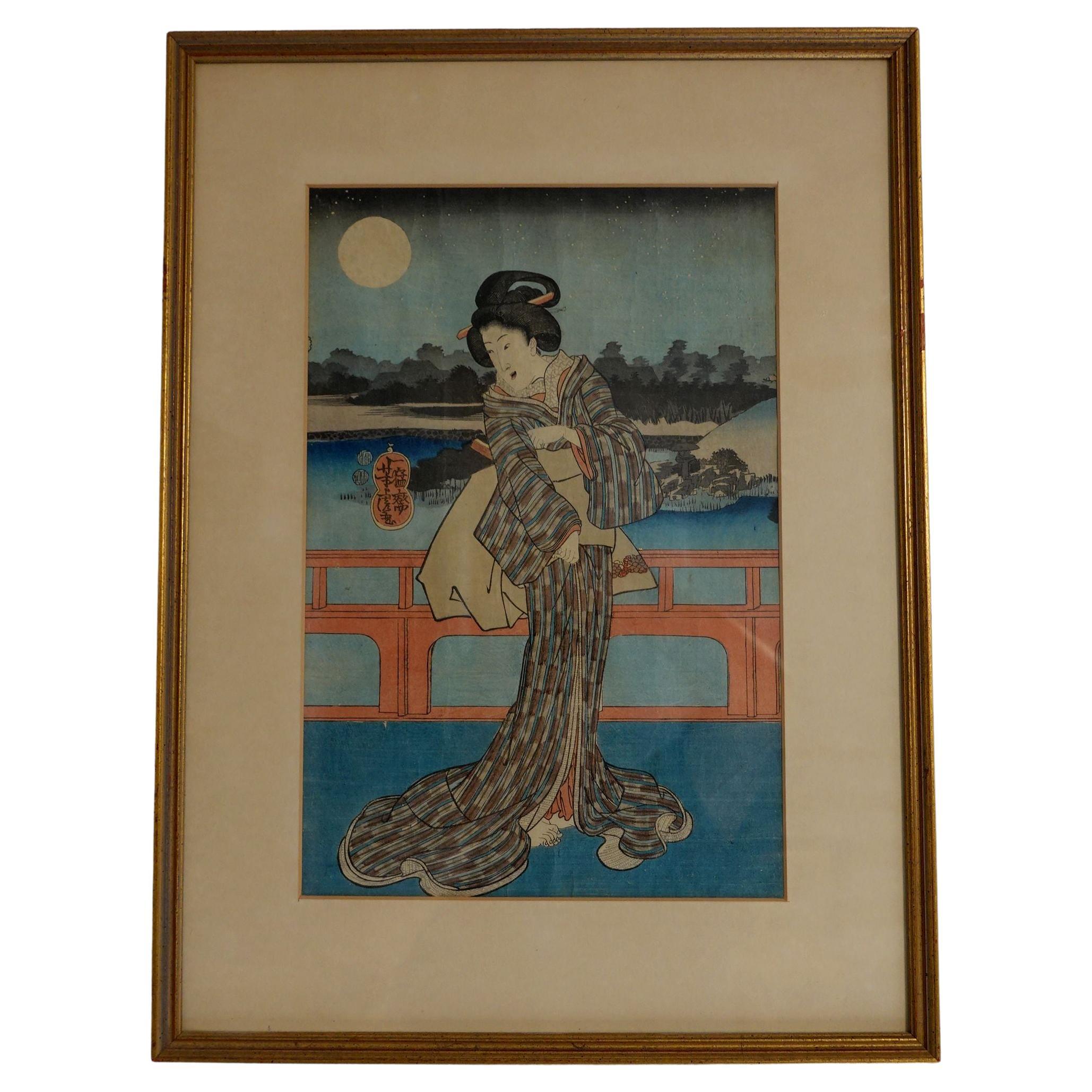Items Similar to Japanese Woodblock Print by Okumura Masanobu '奥村政信'
Want more images or videos?
Request additional images or videos from the seller
1 of 9
Japanese Woodblock Print by Okumura Masanobu '奥村政信'
About the Item
Okumura Masanobu (????) (artist late 1680s - early 1760s)
Signed: Hogetsudo shomei Okumura Bunkaku Masanobu shohitsu
?????????????
Artist's seal: Tanchosai
ABOUT THE ARTIST
Okumura Masanobu (????) (artist late 1680s - early 1760s)
ALTERNATE NAMES:
Baio (go - ??)
Bunkaku (go - ??)
Chikatai (family name)
Gempachi (nickname - ??)
Genroku (nickname - ??)
Hogetsudo (go - ???)
Masanobu (go - ??)
Shidoken (go - ???)
Tanchosai (go - ???)
Okumura Shinmyo (family name - ????)
BIOGRAPHY:
Common name: Genpachi (Genpachiro); go Shinmyo (from 1707), Baio (from 1707), Hogetsudo (from Genbun era, 1736-41), Tanchosai and Bunkaku (both from Enkyo era [?], 1744-8). Ukiyo-e painter, print artist and innovative print publisher, also author and illustrator early in his career. Studied haikai poetry under Tachiba (Shogetsudo) Fukaku (Sen'o, 1662-1753). Said to have been influenced by the work of Moronobu. and Kiyonobu., and his earliest dated work is a copy of Kiyonobu I's Illustrated Book of Courtesans of 1700. published by Kurihara Choemon in the eighth month of 170a. From 1703 to 1711 he designed illustrations for at least 22 ukiyo-zoshi novels and puppet theatre playbooks, notably three works also written by him that parodied Tale of Genji. In the Hoei and Shotoku eras (1704-16) Masanobu designed o-oban prints of beautiful women, horizontal oban sumizuri-e 'parody pictures' (mitat-e) and actor prints, and hosoban tan-e actor prints - all influenced by the prevailing Torii and Kaigetsudo school styles. Masanobu's later actor prints concentrate on female roles, leaving leading male parts to the Torii artists. The most complete listing of sets of sumizuri-e by Masanobu contains fourteen items, each of which probably originally comprised twelve designs and was sold as a folding album. These established the range of subjects and treatments for mitat-e by many later 18th century artists. From 1718 Masanobu produced hosoban beni-e for various publishers and, by the following year at the latest, was publishing designs himself under the Okamura-ya imprint from premises located at Torishio-cho (subsequently adopting as his trademark a gourd-shaped publisher's seal). The beni-e often used the new decorative technique of painting deer glue (nikawa) over areas of black to produce a sheen resembling black lacquer (urushi-e, 'lacquer pictures'). Masanobu credited himself with many other innovations in technique, format and style made in ukiyo-e printmaking during the second quarter of the 18th century, but, as with his frequent claims that his 'genuine' works were being pirated, it is hard to judge to what extent this was advertising hyperbole. Certainly, from the early 1740s he was very active in two new important print genres: 'pillar pictures' (hashira-e) and perspective pictures (uki-e, 'floating pictures'). The earliest benizuri-e (two-colour prints, generally in red and green) known by him is a picture calendar (egoyomi) of 1742. From c. 1750 he also used the new larger oban print format. Other innovations with which he may have been connected were triptychs of hosoban prints and so-called 'stone print pictures' (ishizuri-e) - woodblock prints featuring white outlines in reserve against black backgrounds, like a stone rubbing. His erotic masterpiece in the print medium is the album of hand-coloured oban designs Neya no hinagata, which is generally dated to the Genbun (1736-41) or Kanpo (1741-4) era. In the early 1740s Masanobu may have handed over the running of his publishing business to a successor, Okumura-ya Genroku, and seems to have ceased artistic activity altogether during the later Horeki era (1751-64), perhaps after 1756.
More than 30 paintings by Masanobu have been published, mainly of courtesans but including a few actors. His most notable erotic work in this medium is a handscroll given the title Neya no iro-goromo (Museum of fine Arts, Boston, 09.241), dated to the Shotoku era. Several paintings treat or parody joruri themes encountered in his printed mitate-e, including the meeting between Princess Shokushi and Fujiwara no Teika at the latter's villa at Mount Ogura, and Matsukaze, Murasame and Yukihira at Suma. Also of note is the half-Size, six-panel folding screen Performance at the Nakamura Theatre (Nakamura-za kabuki shibai byobu, Idemitsu Museum of Arts, Tokyo), which was painted in the seventh month of 1731 and records that year's New Year performance at the Nakamura Theatre.".
- Dimensions:Height: 8.5 in (21.59 cm)Width: 11.125 in (28.26 cm)Depth: 0.15 in (3.81 mm)
- Materials and Techniques:
- Place of Origin:
- Period:
- Date of Manufacture:1740s
- Condition:Wear consistent with age and use.
- Seller Location:Norton, MA
- Reference Number:1stDibs: LU5848233606662
About the Seller
5.0
Platinum Seller
These expertly vetted sellers are 1stDibs' most experienced sellers and are rated highest by our customers.
Established in 2000
1stDibs seller since 2021
83 sales on 1stDibs
Typical response time: <1 hour
- ShippingRetrieving quote...Ships From: Norton, MA
- Return PolicyA return for this item may be initiated within 3 days of delivery.
More From This SellerView All
- Japanese Woodblock Print by Shûtei Tanaka '秋亭'Located in Norton, MAThe painting presents a very old and traditional Japanese belt with hidden space to store small things such as pills, rings, and jewelry. Tanaka Shutei(1810 ~ 1858) Tanka was a ...Category
Antique Early 19th Century Japanese Prints
MaterialsPaper
- Japanese Woodblock Print by Keisai Eisen 渓斎 英泉Located in Norton, MAJapanese Woodblock Print by Keisai Eisen ?? ?? (1790~1848), original and unframed. ABOUT THE ARTIST Keisai Eisen (?? ??, 1790–1848) was a Japanese u...Category
Antique Early 19th Century Japanese Prints
MaterialsPaper
- Japanese Woodblock Print by Utagawa Toyokuni ILocated in Norton, MAJapanese Woodblock Print by Utagawa Toyokuni I (1769~1852), original and unframed. ABOUT THE ARTIST Utagawa Toyokuni (Japanese: ????; 1769 in Edo – 24...Category
Antique Early 19th Century Japanese Prints
MaterialsPaper
- Japanese Woodblock Print by Eizan Kikugawa, 菊川英山Located in Norton, MAJapanese Woodblock Print by Eizan Kikugawa,???? (1787~1867) ABOUT THE ARTIST A native of Edo, Eizan Kikugawa was born as Toshinobu Omiya in 1787. He began his artistic career s...Category
Antique Early 19th Century Japanese Prints
MaterialsPaper
- Japanese Woodblock Print by Utagawa Yoshiiku 落合芳幾Located in Norton, MAJapanese woodblock print by Utagawa Yoshiika 落合芳幾 (1833-1904), unframed. About the Artist: Yoshiiku was a popular ukiyo-e printmaker during the Meiji period. It is thought that he was the son of a tea house proprietor, hence his particular skill success in the portrayal of various beauties from teahouses and restaurants. Yet, he was an artist comfortable across subject matter and is recognized for his fierce portrayal of famous historical warriors. Yoshiiku was a student of Kuniyoshi and a contemporary rival of the famed Yoshitoshi. He signed his name Utagawa Yoshiiku...Category
Antique Mid-19th Century Japanese Prints
MaterialsPaper
- Antique Japanese Woodblock Print by Utagawa Yoshitora, 一猛齋芳虎Located in Norton, MAAntique Japanese woodblock print by Utagawa Yoshitora 一猛齋芳虎 (1836~1880) depicting a night scene with a courtesan, Framed with glass. Dimensions: with...Category
Antique Mid-19th Century Japanese Prints
MaterialsPaper
You May Also Like
- Nine Japanese Woodblock Prints by Utagawa KuniyoshiBy Utagawa KuniyoshiLocated in Petworth, West SussexUtagawa Kuniyoshi (Japan, 1798-1861), a set of nine Japanese woodblock prints (ukiyo-e) from the series 'Taiheiki Eiyuden', or 'Heroes of the Great Peace' published between 1846-1847...Category
Antique Mid-19th Century Japanese Edo Prints
MaterialsPaper
- Japanese Color Woodblock Print by Toyohara ChikanobuBy Toyohara ChikanobuLocated in New York, NYThis Meiji-period color woodblock by Toyohara Chikanobu (1838-1912) depicts three elegant female courtiers in traditional dress taking refreshments. Th...Category
Antique Late 19th Century Japanese Meiji Prints
MaterialsPaper
- 1969 Graphic Woodblock Print by Tomio Kinoshita, JapanBy Tomio KinoshitaLocated in Point Richmond, CAFaces (4 Faces), 1969 Tomio Kinoshita (1923-2014), Japan Woodblock print Paper, pigment, sumi ink Image: 27 high by 18.25 inches wide (68.5 by 46.4 cm) Paper size: 28 high by 19...Category
Vintage 1960s Japanese Mid-Century Modern Prints
MaterialsPaper
- 1981 Graphic Woodblock Print by Tomio Kinoshita, JapanBy Tomio KinoshitaLocated in Point Richmond, CATomio Kinoshita (1923 - 2014) Masks (No. 4), 1981 Woodblock print Image Size: 22 high by 31 inches wide (56 by 79 cm) Paper Size: 22.75 high by 31.5 inches wide (57.8 by 80 cm) ...Category
Vintage 1980s Japanese Mid-Century Modern Prints
MaterialsPaper
- Reika Iwami, Contemporary Japanese woodblock printBy Reika IwamiLocated in Point Richmond, CAContemporary Japanese woodblock print (Sosaku hanga) by the female artist Reika Iwami (b. 1927, Tokyo) titled “Water Fantasy A”of a setting full moon on th...Category
Vintage 1980s Japanese International Style Prints
MaterialsPaper
- Original Japanese Woodblock Print of a Warrior by Gyokusei Tsukioka 月岡 玉瀞By Gyokusei TsukiokaLocated in Amsterdam, NLOriginal Japanese woodblock print by Gyokusei Tsukioka (1908-1994): a warrior (samurai) from the series ‘Noh Play Prints of the Hosho School’ (Hosho-ryu Noh Gaku Hanga). An actor donning a ferocious mask is clad in an impressive and ornately decorated full samurai kimono (kamishimo), has a katana (sword) drawn in his right hand and is holding the other hand above its head. Date: Around 1930 Type: Shin Hanga Format: Oban Sealed in front: Gyokusei Signed and sealed at the back. Tsukioka Gyokusei, the daughter of the artist Tsukioka Kogyo...Category
Vintage 1930s Japanese Prints
MaterialsPaper
Recently Viewed
View AllMore Ways To Browse
Antique Pictures
Asian Influence Furniture
Japanese Stone Art
Japanese Influence Furniture
Japan Book
Japanese Black Stone
Asian Midcentury Artist
Antique Paper Paint Color
Asia Picture
Antique Novel
Antique Novels
Antique Picture Prints
Boston School
Mid Century Asian Influence
Horizontal Japanese
Asian Painters
Black And White Midcentury Prints
18th C E
